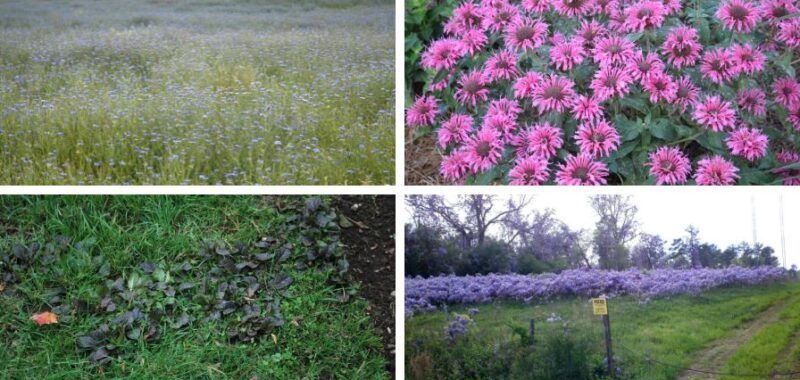
(Clockwise from top left) These bachelor’s buttons are naturalized, meaning they are non-native but have adapted to their environment here in Athens, GA. Monarda ‘Balmy Pink’ is a nativar, meaning it is cultivated from a man-made cross. Asian wisteria is invasive (originally from Asia) and escaped here in Athens, GA. This native ajuga is aggressive and growing out of bounds, but it is not considered invasive. | Allan Armitage
It seems everyone has an opinion about plants we broadly call natives and nativars. Landscapers, designers, installers, and those who sell perennials, shrubs, and trees have become particularly enamored. And why not? The term native has become an established trend, and the plants have become an important piece of the marketplace.
But there is a ton of confusion out there. People are puzzled about the differences between native, nativars, invasive plants, aggressive plants, and even naturalized plants. We may bandy these terms about, but please believe me, most people don’t really know what we are talking about.
When we talk to the landscape/gardening community (and to each other), we must be sensitive to misunderstandings. When my neighbor hears that a plant may be invasive, the knee-jerk response is to shut down. On the other hand, let them know it is a native, and they want to hear more.
So, we should get these things somewhat correct or at least stay out of trouble by not giving wrong information.
Native
The definition of native is fluid. Most people tend to accept the broad definition that a native plant grew wild in a particular region prior to settlement by Europeans.
Another less restrictive definition states that native plants occur within a region as a result of natural processes (e.g., birds and weather events) rather than human intervention. They both cite the importance of region (i.e., a plant native to the Southeast may not be native to the Midwest), but the original defines a specific time frame while the latter suggests that natural processes can and do alter the native landscape.
Therefore, the list of what is native may change over time.
Nativar
Many naturally occurring hybrids can be found in the wild. For example, natural crosses of a white and red flower may produce a pink form of a native species. These are referred to as varieties and, for all intents and purposes, can be considered native.

Monarda ‘Balmy Pink’ is a nativar, meaning it is cultivated from a man-made cross. | Allan Armitage
But, when a breeder crosses a red and white form of a native species, this man-made form is a nativar. There is absolutely no way that, according to these accepted definitions, a nativar can be considered native.
However, the claims that nativars result in a decline of pollinators compared to the species is simply not confirmed by research. In fact, some are far better attractors than the species from which they are crossed.
So, to stay out of trouble, sell the new fancy monarda as a nativar, but not as a native. And don’t apologize to the pollinators.
Invasive vs. Aggressive
There is no excuse for anyone to be selling plants invasive to the region to anyone. Lists of invasives are readily available. So selling yellow flag iris or Japanese privet or Asian wisteria makes us all look bad.
However, people confuse aggressive with invasive, and that hurts us just as much. An aggressive plant is just that, it is aggressive in the garden. Thyme, culinary sage, or ajuga may not be good choices for gardeners/landscapers; they may curse the day they bought them. However, they are not invading the woodlands or pastures.

This native ajuga is aggressive and growing out of bounds, but it is not considered invasive. | Allan Armitage
Good grief, that is why we love groundcovers — they cover the ground. Do not let your staff be intimidated by someone getting upset because Sedum ‘Angelina’ is too successful. It is aggressive, not invasive.
Naturalized
Lastly, allow me to mention the other elephant in the room, naturalized plants. We don’t get many questions about these because we don’t really sell a lot of them. But, we should understand that some non-native plants have evolved and adapted to their new environments along roadways, in turf, or even in meadows.
They are so common (but not always invasive) that they have become more or less accepted as native. That they take the place of native plants is obvious, but they do not have the same negative connotation as invasive. Kudzu and privet are invasive, forget-me-nots and bachelor’s buttons not so much.

These bachelor’s buttons are naturalized, meaning they are non-native but have adapted to their environment here in Athens, GA. | Allan Armitage
In fact, some reports suggest that plants that are considered naturalized (but not invasive) may find their way on native plant lists. Personally, I don’t agree that dandelions, teasel, dame’s rocket, or mullein should be considered native, ever.
Lastly, this whole native/nativar movement has been a benefit to sales and opened the floodgates for discussions about pollinators and invasives — all good things. But, oh my, there is so much more in our plant cupboards than natives. Let’s not get boring — let’s shout out for diversity!
0
1
5
Putting Natives and Nativars in Perspective

